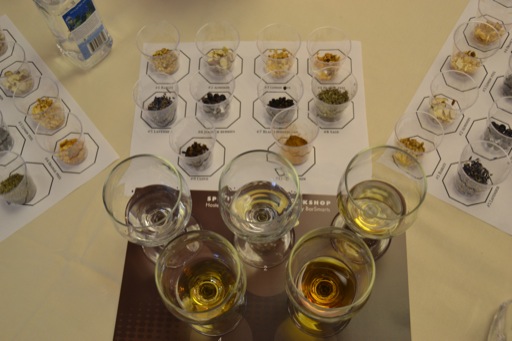Paul Pacault’s Ultra Advanced Spirit Critic’s Workshop
August 2, 2011 by The Boozeniks
Filed under Spirits Events
Paul Pacault, publisher/editor of The Spirit Journal led us through his Ultra Advanced Spirit Critic’s Workshop, and while it lacked some of the white-labcoat science of Per Hermanson’s vodka tasting seminar from 2010’s Tales of the Cocktail, it was a detailed and humorous ride through a how-to of what to smell, taste, and look for when exploring a spirit, and how some of those flavors and aromas come about.
We sampled 5 spirits, and comparison and contrast of those spirits made for some interesting “where’d that flavor come from?” discussions. Here are a few key take-aways that have helped us with how we taste and think of spirits:
Firstly, Paul discussed a substantial difference between nosing and tasting wines, and nosing and tasting spirits: the proof. Sticking your nose in the glass and deeply inhaling is a terrible idea. This is not 13% alcohol wine. This is 80 or more proof! The volatiles will burn the nose out, and desensitize it. He also brought up some differences he has with a fellow spirits expert, Gaz Regan who never swirls the spirit in his glass before tasting. Paul does it to blow some of the harsher chemicals out of the glass so the finer points can be noticed. Gaz’s take is apparently that too much of the real nose of the spirit is lost by swirling. For what it’s worth, we’re still undecided on the swirl vs. no argument, but this discussion did help us become a bit more consistent with our technique.
Also the specific effects of different types of wood maturation was discussed in some detail. We’ve all heard “new American oak” or “French oak”, but what difference does it really make? Turns out there are numerous real differences and reasons why. Basically it boils down to wood grain porosity and durability. American and French oak are actually different species. American oak is more porous but able to be sawn and shaped easily. French oak is denser, but in some ways more fragile, and French oak must be split rather than sawn, lest it risk leaking. Since the French oak is more difficult to work with, it’s more expensive. Since it’s more dense, it has a slower effect. So, why bother? Well, since they are different species in different environments they will impart different flavors, regardless of the faster or slower rate at which spirits mature in one versus the other. American oak is higher in acids which yield coconut and vanilla notes. French oak yields more tannins and honey and maple flavors.
Another interesting take-away was Paul’s departure from the traditional categorization of Scotch into Islay, Highland, Speyside, etc. He believes dividing between maritime and inland is a more useful differentiation. Given some similarities between Islay and Campbeltown whiskies, and lack of clear differentiation between Highland and Speyside other than literal geography, I suppose I can understand this. But I do find this new nomenclature at odds with tendencies these days for AoC/DoC designations to be sought and fought over.








